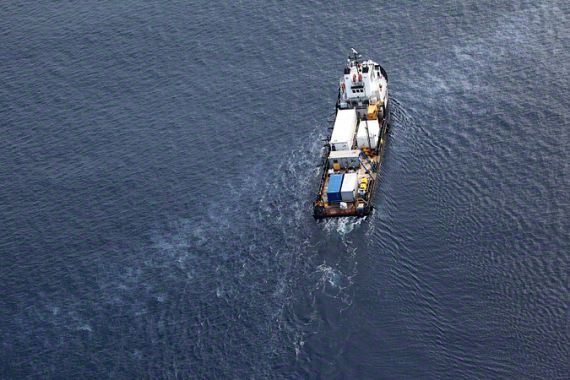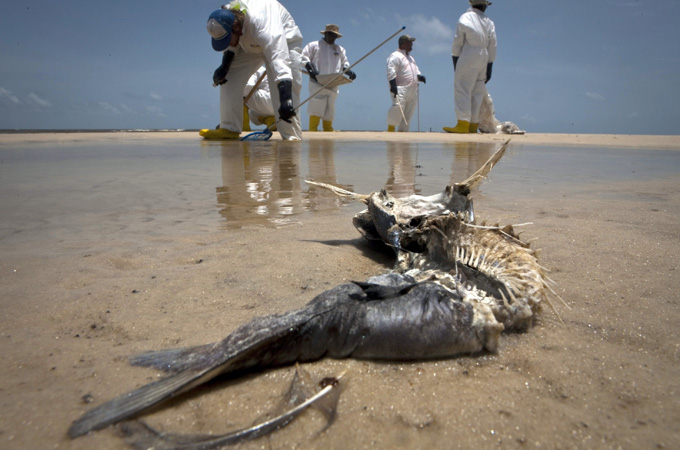BP accuses Halliburton of hiding evidence
Oil giant accuses Halliburton of destroying evidence showing sub-standard cement work led to Gulf of Mexico oil spill.

 |
| British Petroleum says evidence of Halliburton cement testing went ‘inexplicably missing’ [Reuters] |
BP has accused Halliburton of intentionally destroying evidence to conceal the results of tests that showed that sub-standard cement work by the US company led to the Gulf of Mexico oil spill last year.
In documents filed at a New Orleans federal court on Tuesday, BP asked a federal judge to sanction Halliburton Energy Services Inc, the oilfield services company’s main business unit.
BP said Halliburton would not provide computer modelling evidence that their cement work on the Gulf of Mexico oil well that blew out last year was inadequate, and said the evidence on cement slurry testing went “inexplicably missing”.
“Halliburton’s refusal has been unwavering, despite repeated BP discovery requests and a specific order from this court,” the company said in court documents.
“Halliburton intentionally destroyed the evidence related to its non privileged cement testing, in part because it wanted to eliminate any risk that this evidence would be used against it at trial,” the court document said.
BP has cited recent depositions and documents from Halliburton itself in its filings.
Trial expected
Al Jazeera’s Alan Fisher, reporting from Washington, said the charges are “all about the concrete block built around an oil well to stop a blow-out.”
The accusation raises stakes ahead of a trial expected early next year to assign blame and damages for the April 2010 blowout of the Macondo.
The five-month-long spill, the largest in US history, led to the deaths of 11 workers, caused millions in ecological damages and has brought forth tens of billions of dollars in lawsuits.
Fisher said BP accused Halliburton of “at best [losing] the information and at worst actually destroying” the evidence.
The oil company said Halliburton had appeared to have lost computer evidence depicting how the cement performed, but Halliburton said that information is “gone”.
BP has asked a US district judge in New Orleans to rule that Halliburton’s slurry design was “unstable,” a fact which BP could use at next year’s trial when it will be decided who is responsible for the damages in the 2010 spill.
BP has also asked judge Carl Barbier to rule that forensics experts be hired to retrieve the computer data in question.
Beverly Blohm Stafford, a Halliburton spokeswoman, said the company was reviewing the motion but “the conclusion that BP is asking the court to draw is without merit and we look forward to contesting their motion in court”.
‘Pointing a finger’
“These remedies are amply warranted in law and by principles of fair play, and they are essential to ensure this
court’s trial is not tainted by Halliburton’s misconduct,” BP said in the filing.
According to the court documents, Halliburton maintains that its foaming cement formula was stable and performed as designed.
Halliburton also contends that BP chose to use too few “centralisers” to keep the pipe aligned in the well, which allowed hydrocarbons to escape through channels that formed in the cement liner, the documents filed by BP said.
BP said Halliburton witnesses and documents uncovered in pre-trial proceedings bring both defences into question.
Our correspondent says that by filing these accusations against Halliburton early, BP is “pointing a finger at Halliburton and saying they did not do their job properly” ahead of February’s trial.
Halliburton has accused BP of fraud and defamation.
In October, BP, Transocean – the Swiss company that owned and operated the drilling rig – and Halliburton were all cited by the US government for violation of oil industry regulations over the Macondon disaster.
BP had previously sued Transocean Ltd, which owned the Macondo rig, and Cameron International Corp, which made a blowout preventer, for their roles in the spill.